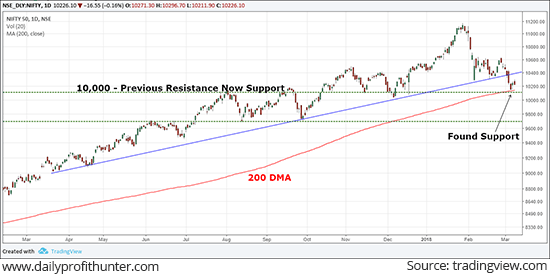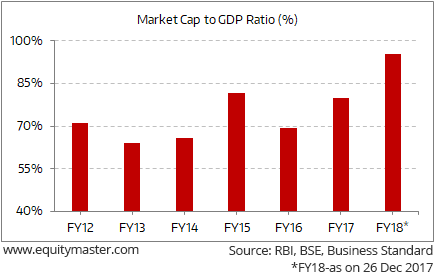- Home
- Todays Market
- Indian Stock Market News March 9, 2018
Sensex Finishes Marginally Lower; Bank & Metal Stocks Fall the Most Fri, 9 Mar Closing
Indian share markets witnessed selling pressure in the final hour of trading session to finish marginally lower amid mixed international markets.
At the closing bell, the BSE Sensex closed lower by 44 points and the NSE Nifty finished lower by 16 points. The S&P BSE Mid Cap finished down by 0.4% while S&P BSE Small Cap finished down by 0.3%. Losses were largely seen in PSU stocks, bank stocks and metal stocks.
We generally refer to PE or price to earnings ratio to gauge whether the market is undervalued or overvalued. If we go by this ratio, the Indian market is clearly in overvaluation territory.
There is still another ratio, which is frequently used to evaluate the valuations. The market capitalization to GDP ratio. It is one of Buffett's favourite indicators of broader market value. The market cap of all the listed companies in the country divided by the gross domestic product (GDP) of the country gives us this ratio.
Market Cap to GDP Ratio Close to 100%
The idea behind this ratio is simple. Stock prices are derived from expected earnings for corporates and GDP represents revenue of the country. This gives investors an estimate of whether the two are moving in tandem. A ratio above 100% shows overvaluation and one below 50% shows that the market may be undervalued.
Even this ratio is showing valuations reaching its peak levels. India's market cap to GDP ratio reached 95%. This ratio was more than 100% after the 2007 bull run. Stock prices had seen a significant meltdown after that amid the global financial crisis.
Asian stock markets finished on a positive as of the most recent closing prices. The Hang Seng gained 1.11% and the Shanghai Composite rose 0.57%. The Nikkei 225 gained 0.47%. European markets are broadly lower today with shares in Germany off the most. The DAX is down 0.43% while France's CAC 40 is off 0.14% and London's FTSE 100 is lower by 0.02%.
Rupee was trading at Rs 65.07 against the US$ in the afternoon session. Oil prices were trading at US$ 60.31 at the time of writing.
Moving on to news from banking sector. As per an article in The Livemint, HDFC Bank Ltd has appointed arrangers, including Bank of America Corp, Morgan Stanley and Credit Suisse Group AG, for a Rs 155 billion (US$2.38 billion) planned share sale.
HDFC Bank plans to raise the bulk of the funds from international investors through a sale of American depository receipts, with the rest to come from selling stock in India. The money will be used to boost the company's capital buffers and support its growth plans for several years.
HDFC Bank approved in December a fund raising of as much as Rs 240 billion through a share sale. Parent company Housing Development Finance Corp. will invest about Rs 85 billion.
HDFC bank share price finished the day down 0.2% on the BSE.
In news from airline stocks, IndiGo plans to order as many as 50 Airbus SE A330 wide-body jets as it seeks to expand beyond short-haul flights.
As per The Livemint, the deal would be worth US$13 billion at list prices for the smaller of two variants. IndiGo is developing plans for long-haul flights after building up a fleet of more than 150 Airbus A320 narrow-body planes used within the region.
Aviation stocks have had a good run in 2017. Market returns from all three listed Indian players have been robust with Spicejet amongst the top gainers in the current year. With the September quarterly results out, it looks like the upswing might continue for few stocks, for some more time, at least.
Indigo and SpiceJet have shown robust sales and operating profit growth, despite the rising crude oil prices. Meanwhile, Jet Airways has slumped because of poor growth in its international business sector.
The recent past has shown us that Indian carriers with a domestic sector focus have reaped better rewards. Jet Airways suffered due to its exposure in the Middle-East.
Lower domestic capacity addition has allowed flights to pass on the fuel price increase to flyers. The long-term sustainability of this run is anyone's guess. This combination of higher crude oil prices and excess capacity is likely to reduce margins going forward.
Despite positives, the airlines industry back home is plagued by cutthroat competition and rock-bottom fares.
In news from the economy, the Economic Affairs Secretary Subhash Chandra Garg has expressed hopes that the growth recovery of Indian economy will continue to be sharp going ahead, as the 7.2% expansion in the economy during October-December quarter (third quarter) has put the country in one of the highest growth bracket in the world.
Earlier, he said that in the first quarter of current fiscal year 2017-18 (FY18), the economy bottomed out, and would see a very strong V-shaped recovery, and the growth in the second and third quarter brings evidence to that.
Garg further said there is no reason for the V-shaped recovery not to continue henceforth. Besides, 7.2 % growth in third quarter of FY18 was highest in five quarters, while the previous high was recorded at 7.5% in the July-September quarter of FY17. In Q1 FY18, the Gross Domestic Growth (GDP) grew at 5.7%, while in Q2 FY18 growth stood at 6.5%.
Talking about the country's sovereign rating, Economic Affairs Secretary said that the global rating agency had a good assessment of India's future prospects. He added that Fitch assessment about the Indian economy, reforms, and path forward seems to be extremely positive but whether it will result in a certain kind of upgrade and when, that is for the rating agency to decide.
And here's a note from Profit Hunter
The Nifty 50 Index traded on a negative note during the week.
On Monday, it opened the session gap down and plunged 100 points. The negative momentum continued until mid-week where the index slipped to a low of 10,141. It bounced back nearly 90 points towards the end of the week. Today, the index resumed its down move and finally ended its weekly session 2.21% down.
Last week, we observed the index finding support from the rising trendline (blue line). But this week, it broke below this trendline and plunged to touch a low of 10,141.
The index has now found a strong support near this level from the horizontal line (previous resistance now support). The 200 day moving average (DMA) also acted as a good support for the stock.
So can the index resume its up move after finding support from horizontal level and 200 DMA? Or will it break this support level as well. Let's wait and watch...
Nifty 50 Index Plunges 2% for the Week

For information on how to pick stocks that have the potential to deliver big returns, download our special report now!
Read the latest Market Commentary



Equitymaster requests your view! Post a comment on "Sensex Finishes Marginally Lower; Bank & Metal Stocks Fall the Most". Click here!
Comments are moderated by Equitymaster, in accordance with the Terms of Use, and may not appear
on this article until they have been reviewed and deemed appropriate for posting.
In the meantime, you may want to share this article with your friends!